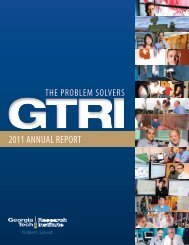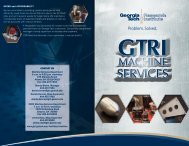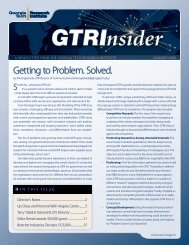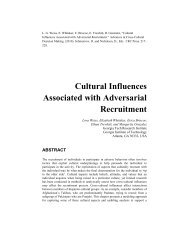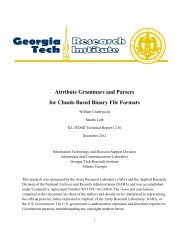Thirdly, <strong>the</strong> file comm<strong>and</strong>’s procedural tests <strong>for</strong> recognition <strong>of</strong> languages (e.g., English, PL/1,Pascal, Java code, HTML) are based on keywords <strong>and</strong> are unreliable. <strong>Magic</strong> tests using regularexpressions should be explored as an alternative.Even if procedures with greater expressive power than magic tests are required to identify somefile types, <strong>the</strong>se procedures could be included as procedural tests in <strong>the</strong> <strong>File</strong> Format Library. Anoption to compile <strong>the</strong>m as part <strong>of</strong> <strong>the</strong> file comm<strong>and</strong> could be added to <strong>the</strong> <strong>File</strong> Format Library.6. Related ResearchTresh et al [1995] developed a vector space classifier <strong>for</strong> identifying file types. It identifies 47classes <strong>of</strong> <strong>UNIX</strong> files using 206 features. The per<strong>for</strong>mance <strong>of</strong> <strong>the</strong> vector space classifier wascompared, with regard to speed, accuracy <strong>and</strong> extensibility, to discriminant analysis, a decisiontree classifier [Quinlan 1993], a rule-based classifier [Hong 1994], <strong>and</strong> a decision table classifier[<strong>UNIX</strong> file comm<strong>and</strong> <strong>and</strong> magic file]. Tresh did not present detailed per<strong>for</strong>mance numbers, butconcluded that <strong>the</strong>ir vector space classifier outper<strong>for</strong>med <strong>the</strong> o<strong>the</strong>r four methods with regard tospeed, accuracy <strong>and</strong> extensibility. Discriminant analysis was very slow because <strong>of</strong> <strong>the</strong> extensivecomputations per<strong>for</strong>med, had high error rates, <strong>and</strong> was not incrementally extensible. The vectorspace, decision tree <strong>and</strong> rule-based classifiers provided comparably fast training <strong>and</strong>classification. The vector space, decision tree, <strong>and</strong> rule-based classifiers had low error rates inapproximately <strong>the</strong> same range (2.1 to 5%). The decision table [file comm<strong>and</strong> <strong>and</strong> magic file]classifier had error rates up to 30%. The decision tree, rule-based, <strong>and</strong> decision table classifierswere judged not to be easily extensible because extension to new classes required rebuilding <strong>the</strong>trees, rules, tables from scratch, whereas <strong>the</strong> feature centroid matrix <strong>of</strong> <strong>the</strong> vector space classifiercould be incrementally extended with coefficients <strong>for</strong> newly added classes, without having torecompute <strong>the</strong> existing centroid coefficients.The version <strong>of</strong> <strong>the</strong> file comm<strong>and</strong> <strong>and</strong> magic file used in this experiment was probably version1.29-1.33. The current file comm<strong>and</strong> (<strong>and</strong> magic file) reliably recognizes all 47 <strong>of</strong> <strong>the</strong> classes <strong>of</strong>files that were used in this experiment.Ano<strong>the</strong>r approach to identifying file <strong>for</strong>mats is by <strong>the</strong> byte frequency distributions <strong>of</strong> files. <strong>File</strong>contents are a sequence <strong>of</strong> bytes <strong>and</strong> a byte has 256 unique values. Thus, counting <strong>the</strong> occurrence<strong>of</strong> <strong>the</strong> byte values in files <strong>of</strong> a particular file <strong>for</strong>mat might be a way to build representativemodels <strong>for</strong> file types. McDaniel [2001, 2003] investigated this method <strong>and</strong> two extendedmethods, byte frequency cross-correlation <strong>and</strong> byte header-trailer pr<strong>of</strong>iles. The number <strong>of</strong>occurrences <strong>of</strong> a byte value is normalized by dividing <strong>the</strong>m by <strong>the</strong> number <strong>of</strong> occurrences <strong>of</strong> <strong>the</strong>most frequent byte value. The model <strong>for</strong> a file signature, which <strong>the</strong>y term a file fingerprint, is <strong>the</strong>average <strong>of</strong> <strong>the</strong> normalized number <strong>of</strong> occurrences <strong>for</strong> each byte value <strong>for</strong> each sample in a filetype. Models <strong>of</strong> a file type are compared to <strong>the</strong> byte frequency distributions <strong>of</strong> unknown filetypes by computing <strong>the</strong> Manhattan distance, which is just <strong>the</strong> sum <strong>of</strong> <strong>the</strong> differences <strong>of</strong>corresponding bytes in <strong>the</strong> distribution. The methods were tested on 30 file types with 4examples per file type. The byte frequency distribution method had an accuracy <strong>of</strong> 27.5%, <strong>the</strong>byte frequency cross-correlation method an accuracy <strong>of</strong> 45.83% <strong>and</strong> <strong>the</strong> byte header-trailermethod an accuracy <strong>of</strong> 95.83%.15
Li et al [2005] investigate a method <strong>for</strong> file type identification that is based on n-grams. Since<strong>the</strong>y only consider 1-grams, <strong>the</strong> method is also a variety <strong>of</strong> <strong>the</strong> byte frequency distributionmethod. Their method differs from McDaniel’s in several ways. First, <strong>the</strong>y normalize <strong>the</strong> number<strong>of</strong> occurrences <strong>of</strong> a byte value by <strong>the</strong> length <strong>of</strong> <strong>the</strong> file ra<strong>the</strong>r than <strong>the</strong> number <strong>of</strong> occurrences <strong>of</strong><strong>the</strong> most frequent byte value. Fur<strong>the</strong>r, <strong>the</strong>y include in <strong>the</strong>ir model <strong>the</strong> st<strong>and</strong>ard deviation <strong>of</strong> <strong>the</strong>byte values <strong>for</strong> a file type. They also considered modeling <strong>the</strong> 1-grams <strong>of</strong> only fixed portions <strong>of</strong><strong>the</strong> file, e.g., <strong>the</strong> first 20 bytes <strong>of</strong> a file, which <strong>the</strong>y term truncation sizes. They tested <strong>the</strong>irmodels on 8 file types. The average accuracy <strong>of</strong> file type classification was evaluated <strong>for</strong> 1-grammodels <strong>of</strong> <strong>the</strong> entire file as well as truncation sizes from <strong>the</strong> beginning <strong>of</strong> <strong>the</strong> file <strong>of</strong> 20, 200, 500<strong>and</strong> 1000 bytes. The classification accuracy results <strong>for</strong> a truncation size <strong>of</strong> 20 bytes was <strong>the</strong> best.98.9-100%. The classification accuracy <strong>for</strong> 1-gram models <strong>of</strong> <strong>the</strong> entire file was 77.1-98.9%.The number <strong>of</strong> file types considered in each <strong>of</strong> <strong>the</strong> investigations summarized above is too small<strong>and</strong> at too high a level <strong>of</strong> granularity. The number <strong>of</strong> file types that need to be considered inexperiments <strong>and</strong> comparisons <strong>of</strong> methods is on <strong>the</strong> order <strong>of</strong> 1000-2000 file types. Fur<strong>the</strong>rmore,one needs to distinguish between versions <strong>of</strong> a file <strong>for</strong>mat because <strong>of</strong> differences in <strong>for</strong>matbetween versions. None <strong>of</strong> <strong>the</strong> investigations considered file types in <strong>the</strong>ir experiments that weredifferent from <strong>the</strong> file types in <strong>the</strong> training sets, so could not conclude that <strong>the</strong> file type <strong>of</strong> a filewas unknown, that is, not among <strong>the</strong> file types that could be identified.As discussed in section 2, PRONOM is a public file <strong>for</strong>mat registry maintained by The NationalArchives (TNA) <strong>of</strong> <strong>the</strong> UK. DROID is a <strong>File</strong> Format Identifier distributed by TNA. DROIDidentifies <strong>the</strong> file <strong>for</strong>mat <strong>of</strong> a file by file extension (an external signature) or by internal filesignature pattern. An internal signature pattern is composed <strong>of</strong> one or more signature bytesequences. A signature byte sequence is modeled by describing its starting position within abitstream <strong>and</strong> its value.The starting position can be one <strong>of</strong> two basic types:Absolute: <strong>the</strong> byte sequence starts at a fixed position described as an <strong>of</strong>fset from ei<strong>the</strong>r<strong>the</strong> beginning or <strong>the</strong> end <strong>of</strong> <strong>the</strong> bitstream.Variable: <strong>the</strong> byte sequence can start at any <strong>of</strong>fset within <strong>the</strong> bitstream.The value <strong>of</strong> <strong>the</strong> byte sequence is defined as a sequence <strong>of</strong> hexadecimal values, optionallyincorporating regular expressions:The file signature patterns are maintained in <strong>the</strong> PRONOM registry. Figure 4 shows an example<strong>of</strong> <strong>the</strong> metadata <strong>and</strong> <strong>the</strong> file signature pattern <strong>for</strong> <strong>the</strong> Open Document Text file <strong>for</strong>mat whosemagic test was shown in Figure 2.16






